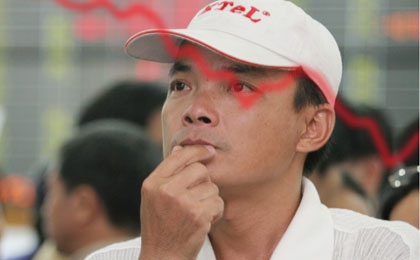Long game to provide results
 But for Vietnam’s stock markets, the forecast remains dreary in the near-term and favours the long-term investor, says Dr. Christian Kamm, president of investment advisory firm Kamm Investment, Inc.
But for Vietnam’s stock markets, the forecast remains dreary in the near-term and favours the long-term investor, says Dr. Christian Kamm, president of investment advisory firm Kamm Investment, Inc.
When we view the current economic landscape of Vietnam, we see a very cloudy picture. Although some of the clouds have lifted over the last ten months, the remaining two months of the year might prove to be a continuation of the cloudy conditions.
Inflation, which has been decelerating throughout the year, is not yet showing worrisome signs.
Although the consumer price index (CPI) for September was more than expected, much of the variance could be attributed to abnormally high medical cost increases. By keeping inflation under control, Vietnam policy-makers have been able to stabilise the dong and therefore limit further capital flight from the Vietnam dong and to stabilise the remittances which rely on a higher level of certainty concerning the value of the dong.
Gross domestic product (GDP) has been accelerating as loose monetary policy and more accommodative fiscal policy has taken hold throughout the year. We can readily assume that the fourth quarter, which is seasonally strong, will again be strong this year. With a further increase in GDP, the likelihood of better corporate earnings will be probable. Better corporate earnings often spur price-earnings expansion and higher stock prices.
The trade situation has also improved noticeably. With a continued orchestrated decline in domestic consumption, import growth has slowed considerably. With the declining dong last year, Vietnamese exports became cheaper in the world market which spurred export growth. The combined effect has been a significant improvement in the trade balance. With this improved trade picture, the foreign exchange reserve situation has also improved.

So why are the prospects for recovery still a cloudy picture? The banking system remains seized up; years of accumulating non-performing loans have possibly restricted the ability of the banking system to increase lending. This could have a significant impact on credit growth and the ability for lending to aid in an economic recovery.
The real estate sector remains stagnant. In developed economies, a deleveraging of the real estate sector might take five or more years to fully resolve; in higher GDP-growth economies with positive demographic trends such as Vietnam, a deleveraging cycle might last only two to three years. Therefore, it is likely that as prices of real estate fall to more reasonable levels, developers will forgo and delay projects, eventually restricting supply and forcing prices to bid up.
This point will mark the beginning of the new recovering cycle for the real estate market. Most investors realize that the bottom of the real estate market might not yet be in sight. Additionally, there are often false starts in real estate recoveries. It is common that real estate recoveries are not experienced in a straight line up, but rather in cycles within cycles.
Uncertainty surrounding the world economies is another cloud that may not lift during the fourth quarter. Political uncertainty in the US and economic uncertainty in the US, the EU and China will prove to be influential to a recovery in the stock markets in Vietnam both over short periods and longer periods of time. Ironically, a bull market in Vietnam is not likely to be sparked from the movements of exogenous markets or economies as growth has a tendency to be gradual, yet, as in 2008, the decline in the world markets saw Vietnamese markets fall in concert.
This is because the effect of a decelerating economic environment in the world has a more sudden and dramatic effect than a more stable level of growth to a country primarily exporting to these countries and a country requiring consistent growth in foreign indirect and direct investment.
Most foreign investors, for example, know that the movements of the markets are critical to understanding the future of the economy of a country. Most foreign investors know that the markets always look ahead. Even if the clouds remain, the market often looks beyond the clouds to foretell of stability or instability over the next six to nine months. The market will foretell of further weakness or further strength; higher or lower inflation; robust or anemic economic growth.
By most fundamental analyses, stocks in Vietnam remain some of the cheapest in the world.
Technically, Vietnamese markets may be forming bases at their current levels. It is difficult to argue that Vietnamese stocks are not cheap. Even if cheap, an investor always wonders if stocks can get cheaper.
Actions of individual investors are often governed by fear – fear of the future, fear of the unknown.
Fear can cause investors to sell and buy securities at the wrong time. Removing emotion from the equation of stock investing is very important to being a successful investor. Securities that are cheap can get cheaper. Securities that are cheap can stay cheap a very long time. But whatever security is cheap and fundamentally sound and good quality will eventually provide investors with a compensatory return.
Fundamentally, every investor seeks to purchase securities at their cyclical lows. How do investors determine the cycle lows? There are technical and fundamental ways to guess a cycle low. But to truly determine the bottom, we must have the courage to purchase when securities are not in favor and when the economic clouds have only started to lift.
Having this courage at this exact time might not mean we buy exactly at the cyclical lows – but we may purchase securities close to these lows – probably providing investors with superior returns.
It is not about finding the bottom, then, but rather having the courage to look forward – as the market does – relying on the trends such as more benign inflation or increasing GDP – as signs that improvement is occurring. It is about knowing that today’s market is not tomorrow’s market.
It is believing in the capabilities of an educated and industrious people to rise above these seemingly inherent problems and to forge economic prosperity again. It is not hard, then, to realise why foreign investors take a “long view” on investing in Vietnam. Local investors can take the cue from foreign investors in this respect.
Sadly, the market will rebound long before most investors will have the courage to purchase securities. The market will move stealthily higher seen by few, bought by fewer. Then, at some point, the previous “compelling valuations” will no longer be compelling. Once the valuations are no longer attractive, most sidelined investors become interested in the market.
The investor that has the courage to purchase securities looking forward to the fourth quarter may well reap the benefits of looking beyond the cloudy picture of today.
What the stars mean:
★ Poor ★ ★ Promising ★★★ Good ★★★★ Very good ★★★★★ Exceptional
 Tag:
Tag:
Related Contents
Latest News
More News
- Securing capital and efficiency for Vietnam’s 2026-2030 growth ambitions (December 17, 2025 | 10:00)
- Energy sector in need of blended finance mechanisms (December 17, 2025 | 09:00)
- Vietnam still has room to mobilise capital for sustainable growth (December 17, 2025 | 08:57)
- Long-term capital seen as key hurdle to green growth (December 16, 2025 | 08:00)
- Gold prices swing amid tax debate and import uncertainty (December 15, 2025 | 18:04)
- Agribank frames bank credit as catalyst for green growth (December 15, 2025 | 17:59)
- Vietnam’s green transition demands collective financial action (December 15, 2025 | 12:00)
- VIR workshop highlights capital and policy for sustainable development (December 15, 2025 | 11:00)
- Promoting digital assets initiative in Vietnam (December 13, 2025 | 09:30)
- Experts flag gaps as national financial strategy under review (December 12, 2025 | 15:13)























 Mobile Version
Mobile Version